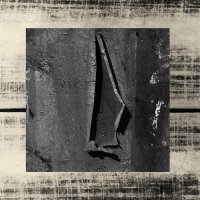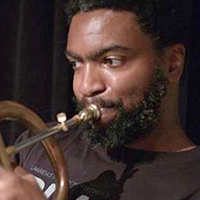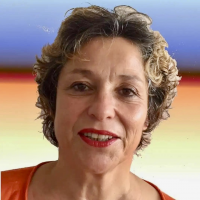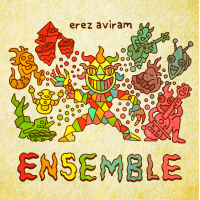Home » Jazz Musicians » Graham Haynes
Graham Haynes
Regarded as an innovator on cornet and flugelhorn, an extraordinary composer, and an emerging force in contemporary electronic music and world music, Graham Haynes has redefined and deconstructed that genre we still call jazz. While his main instrument is the cornet, he is by no means making jazz music these days. Haynes uses technology to create imaginative, subtle sonic environments. Even amidst electronic processing, his horn stands out, providing a level of expression that humanizes and elevates the synthetic sounds.
The son of legendary jazz drummer Roy Haynes, Graham was born in 1960 and raised in Hollis, Queens, where he was surrounded by innovators (his neighbors included Roy Eldridge, Milt Jackson, and Jaki Byard). While studying composition, harmony and theory at Queens College, Graham developed an interest in classical and electronic music (Robert Moog was professor of electronic music at that time). In 1979, he met alto saxophonist Steve Coleman. They formed a band called Five Elements, which launched the M-Base collective, an influential group of New York improvisers. Haynes spent much of the 1980s collaborating with Coleman and Cassandra Wilson. In the late 1980s he formed his own ensemble, Graham Haynes and No Image, and recorded his first album as a leader, "What Time it Be?"
During the late 1980`s, Haynes immersed himself in a wide range of African, Arabic, and South Asian music which prompted his move to Paris in 1990. There he recorded Nocturne Parisian and "The Griots Footsteps", for French PolyGram Records. Haynes spent the next three years studying and performing with masters of African and Asian music, occasionally returning to the U.S. to work with artists such as Ed Blackwell, George Russell, Uri Caine, David Murray and many others. In 1993, Haynes moved back to New York City, where he began investigating sampling and hip hop music. The album "Transition" came out of this investigation. His next project, "Tones for the Twenty-First Century", combined sound effects, textures, drones, and samples, layered over Haynes' electronically manipulated horn.
Graham was extensively working with DJs within drum-n-bass scene in NYC, UK and Europe throughout the 90's. In 2000, he recorded the critically acclaimed "BPM" (Knitting Factory Records), a fusion of drum-n-bass programming and operatic music, specifically the late music of Richard Wagner. Haynes uses technology to create imaginative and even subtle sonic environments, and, of course, he is an evocative player on his primary instrument, the good old-fashioned cornet. "Even amidst all the electronic processing, his horn stands out, providing a level of expression that humanizes and elevates BPM's synthetic sounds." (Dave Lynch, All Music Guide).
Read moreTags
Brandon Ross Phantom Station: Off the End

by Vic Albani
"Navigando tra luce e oscurità, con Off the End, Brandon Ross Phantom Station offre una cerimonia che è allo stesso tempo aperta e strettamente focalizzata, rivelando uno spirito impavido slegato da vincoli stilistici." Le poche parole tratte dalla recensione pubblicata da “Jazz Trail" inquadrano perfettamente e in poche parole il sunto stilistico del nuovo lavoro discografico della straordinaria creatività del signor Ross, in Italia sicuramente e purtroppo poco conosciuto a parte forse l'avventura con il collettivo avant-rock Harriet Tubman accanto ...
Continue ReadingGraham Haynes, Triad, Raffi Garabedian, Chief Keegan & More

by Ludovico Granvassu
The New York residency of Graham Haynes at FourOneOne offers an opportunity to look back at his seminal album The Griot's Footsteps and at his recent collaboration with Brandon Ross. Before that, a playlist rich in remarkable new releases! Happy listening! Playlist Ben Allison “Mondo Jazz Theme (feat. Ted Nash & Pyeng Threadgill)" 0:00 Chief Keegan “Shallow Gander" The Piles High Club (Need to Know) 0:16 Host talks 4:57 Triad “I Put a Spell on You" ...
Continue ReadingYuko Fujiyama: Quiet Passion

by John Sharpe
American-based Japanese pianist Yuko Fujiyama has recorded sparingly over a 40-year career, so the arrival of Quiet Passion, only the fourth date under her leadership, is an occasion to perk up the ears. Also noteworthy is the unusual instrumentation she has chosen, supplementing her piano with the cornet of Graham Haynes and electronics of Ikue Mori. The resultant 13 cuts constitute a deeply personal album, introspective but simmering with pent up emotion and steely determination. Like many ...
Continue ReadingOGJB Quartet: Ode To O

by John Sharpe
An assemblage of stars doesn't always result in a constellation. But astronomers will need to take note in the case of the OGJB Quartet, called after the forename initials of the four members: reedman Oliver Lake, cornetist Graham Haynes, bassist Joe Fonda and drummer Barry Altschul. On the venerable collective's second album Ode To O following their eponymous debut in 2019, one of the most striking traits is how much they sound like a band. As might be expected in ...
Continue ReadingYuko Fujiyama, Graham Haynes, Ikue Mori: Quiet Passion

by Mark Corroto
Pianist Yuko Fujiyama does not routinely release music. When she does, it is always for a special purpose. This trio recording, Quiet Passion, was preceded by Night Wave (Innova Recordings, 2018) and, like her previous album, she is joined by cornetist Graham Haynes. The trio is completed by fellow Japanese- born expatriate Ikue Mori a longtime mainstay of New York's Downtown scene. Fujiyama, a Cecil Taylor devotee, has maintained the essence of Taylor's art but, through the years, she has ...
Continue ReadingThe OGJB Quartet: Ode To O

by Jerome Wilson
The OGJB Quartet, a formidable all-star grouping of saxophonist Oliver Lake, cornetist Graham Haynes, bassist Joe Fonda and drummer Barry Altschul, are back with their second album, one even more wide-ranging and soulful than their first, Bamako, (TUM, 2019). The album combines tracks based on gutbucket rhythms with others full of exploratory abstractions. The album title, Ode To O, refers to Ornette Coleman and the title track, written by Altschul, has he and Fonda laying down an assured ...
Continue ReadingWarriors of the Wonderful Sound: Soundpath

by Mark Corroto
If we alter President John F. Kennedy's 1962 moon spaceflight speech just a bit, it easily fits the big band adaptation of Muhal Richard Abrams' magnum opus Soundpath, “We choose to perform this composition not because it is easy, but because it is hard, because that goal will serve to organize and measure the best of our energies and skills, because that challenge is one that we are willing to accept." Accepting the challenge was band leader Bobby Zankel and ...
Continue ReadingAcclaimed Experimental Wizard Graham Haynes to Release "Full Circle"

Source:
Now Forward Music
Full Circle unites the worlds of free-jazz, drum n bass, noise and experimental electronic music
On June 26, RKM Music/Kindred Rhythm Music Group will release Full Circle - the brand new album from forward thinking musician/composer/sound artist Graham Haynes, who is long known as an artist that cannot be contained by artistic boundaries and styles. Haynes' new album - his first in seven years - features numerous guest musicians and traverses a musical world in which jazz, drum ...
read more
Photos
Music
Ode to O
From: Ode To OBy Graham Haynes





































